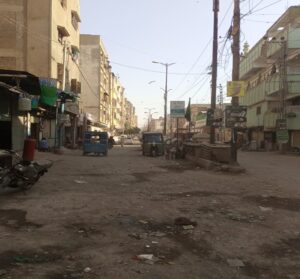 SADAF SULEMAN
SADAF SULEMAN
Lyari Became Karachi’s Hottest and Hardest Place to Live
LYARI, KARACHI — Lyari, one of Karachi’s oldest and most densely populated neighbourhoods, has become a frontline of Pakistan’s escalating climate crisis. Its narrow lanes and concrete rooftops now symbolize the country’s growing urban heat emergency. Once celebrated for resilience and vibrant street life, this community is now suffocating under record temperatures and rising health threats.
Climate records from the Pakistan Meteorological Department (PMD) show that Karachi’s mean annual temperature has risen by 1.5–2°C since 1990. In 2024–2025, the city recorded some of its highest-ever urban heat indexes, frequently exceeding 40°C for multiple consecutive days.
In Lyari, where tree cover is below 1%, concrete surfaces absorb and trap heat, amplifying the urban heat island effect that lingers long after sunset. (Source: PMD Climate Indicators, 2025)
“During peak summer, our rooms feel like ovens,” says Shamim Bibi, a resident of Kalakot. “We barely have electricity for fans, and children fall sick because of the heat.”
According to local hospital staff, heat-related emergency admissions have risen by nearly 27% during 2024–2025 compared with the previous year. Doctors report a sharp increase in heatstroke, dehydration, and respiratory distress, often worsened by power outages and poor indoor ventilation.
The World Health Organization’s Eastern Mediterranean Regional Office (WHO-EMRO) warns that Karachi’s low-income districts are “at critical risk of heat-related mortality and infectious disease outbreaks” as temperatures continue to climb.
Urban planners describe Lyari as a “concrete jungle” , a dense grid of brick, asphalt and corrugated roofs with virtually no green or permeable spaces. With over 64,000 residents per square kilometre, it is one of South Asia’s most crowded urban area.
“Lyari’s built environment traps heat. Without shade trees or open courtyards, the temperature here can be 3–4°C than coastal Karachi,” says Dr. Saima Shakil, an environmental researcher.
Satellite thermal imaging from NASA MODIS (2025) confirms that Karachi’s inner districts including Lyari, Garden and Saddar, now rank among the hottest urban microzones in South Asia.
Beyond heat stress, climate-linked illnesses are multiplying. The Sindh Health Department’s 2025 surveillance bulletin reports a 22% increase in dengue and malaria cases, after the 2025 monsoon, driven by standing water, blocked drains, and poor sanitation.
“Every year, it’s getting worse,” says Fatima Hasan, a mother of three in Lyari’s Nayabad area. “We fear both the heat and the mosquitoes. Hospitals are overcrowded, and medicines keep getting expensive.”
The UN Environment Programme (UNEP) lists Karachi among Asia’s top 10 cities at severe risk of health burdens from heat exposure and vector-borne diseases, due to poor adaptation and limited green infrastructure.
Despite limited municipal action, Lyari’s citizens are fighting back. Local youth, women and activist groups have started tree-planting drives, rooftop cooling projects, and waste-management campaigns, to reduce heat stress and pollution.
“Climate resilience requires both infrastructure and awareness,” says Ayesha Jatoi, environment Spokesperson. “We need coordinated action between government and citizens to survive the new normal.”
For Lyari’s residents, climate change is not a distant threat, it’s a lived daily reality. Each heatwave, flood, and disease outbreak erodes livelihoods and well-being. Yet, amid the hardship, the community’s determination to adapt reflects its enduring spirit of resilience.
